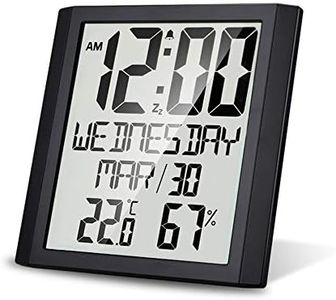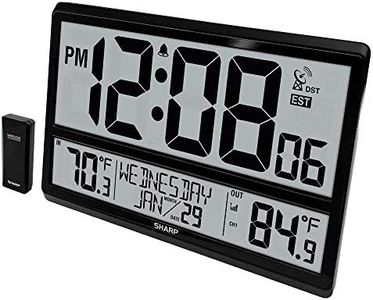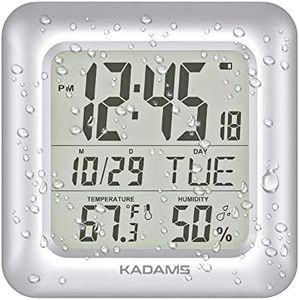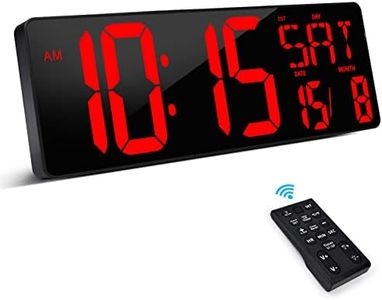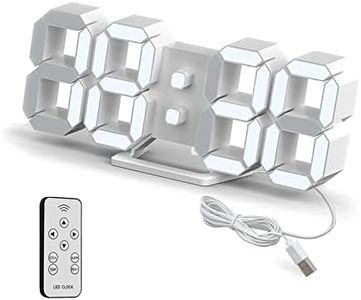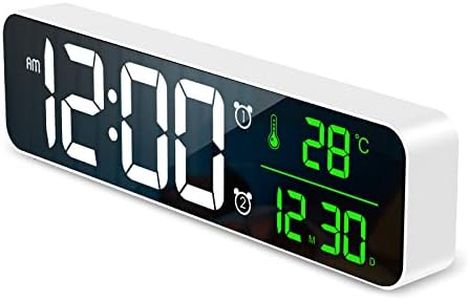We Use CookiesWe use cookies to enhance the security, performance,
functionality and for analytical and promotional activities. By continuing to browse this site you
are agreeing to our privacy policy
10 Best Digital Wall Clocks
From leading brands and best sellers available on the web.Buying Guide for the Best Digital Wall Clocks
Choosing the right digital wall clock is about balancing your style preferences with practical needs. You'll want a clock that's easy to read, fits the design of your space, and has features that match your daily routines. Think about where you'll hang the clock—whether it’s a kitchen, bedroom, office, or classroom—since that influences which features and size will work best for you. Spend a bit of time understanding each key feature to ensure you select a clock that truly makes your life easier.Display Size and ReadabilityDisplay size refers to how large the numbers and overall screen are on the clock. This is important because the easier the clock is to read from a distance or in low light, the more practical it is in everyday use. Generally, digital clocks come with small, medium, or large displays. Small screens may be ideal for tight spaces or personal use up-close, while large screens work better for communal spaces where people need to see the time from across the room. Consider how far you’ll usually be from your clock and if your eyesight needs a bigger display.
Power SourceDigital wall clocks can be powered by batteries, plugged into the wall via an adapter, or sometimes solar power. This matters because the power source determines how flexible the placement of the clock is and how often you'll need to maintain it. Battery clocks are easy to place anywhere and are portable, but require battery changes occasionally. Plug-in clocks don’t need new batteries but are limited to wall sockets and may stop working during outages. Solar-powered clocks are rare and need good natural light. Choose based on your preferred placement and your tolerance for maintenance.
Time Accuracy and AdjustmentSome digital clocks self-adjust by syncing with radio signals or the internet, while others are set manually. Higher accuracy clocks ensure you always have the correct time without adjusting, which is important for punctuality. Manual clocks might drift and need resetting. If you care about always having the precise time or don’t want to bother with occasional resetting, look for self-setting clocks. For casual use where minor deviations are okay, manual is fine.
Alarm and Extra FeaturesMany digital wall clocks offer additional features like alarms, temperature and humidity displays, calendars, or even timers. These extra features can add convenience, especially in offices, kitchens, or classrooms, but they can also make the clock more complicated. Decide if you need more than just the time at a glance—like reminders to wake up or info about the room’s climate. If simplicity is your goal, stick to basic clocks. If multi-functionality helps your routine, look for these added features.
Design and Mounting OptionsDigital wall clocks come in a range of designs, from sleek and modern to basic and utilitarian, as well as different mounting styles (nail hangers, adhesive, stand options, etc.). Design impacts how well the clock matches your decor, while mounting options impact how and where you can display it. Think about your space: if aesthetics matter, pick a style that complements your room, and if you’re limited in how you can hang items (like in a rental), look for flexible mounting solutions.
Visibility Features (Backlight and Contrast)Visibility features refer to how readable the display is in different lighting conditions. Some clocks have backlit displays or high-contrast numbers, making them easy to read both day and night. Backlit clocks are useful in dim spaces or bedrooms, though some prefer not to have a light on overnight. High-contrast displays suit bright rooms. Consider the lighting in the area you plan to use the clock and whether you’ll need it visible in darkness.




